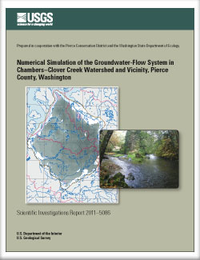A groundwater-flow model was developed to contribute to an improved understanding of water resources in the Chambers-Clover Creek Watershed. The model covers an area of about 491 square miles in western Pierce County, Washington, and is bounded to the northeast by the Puyallup River valley, to the southwest by the Nisqually River valley, and extends northwest to Puget Sound, and southeast to Tanwax Creek. The Puyallup and Nisqually Rivers occupy large, relatively flat alluvial valleys that are separated by a broad, poorly drained, upland area that covers most of the model area. Chambers and Clover Creeks drain much of the central uplands and flow westward to Puget Sound. The model area is underlain by a northwest-thickening sequence of unconsolidated glacial (till and outwash) and interglacial (fluvial and lacustrine) deposits. Ten unconsolidated hydrogeologic units in the model area form the basis of the groundwater-flow model.
Groundwater flow in the Chambers-Clover Creek Watershed and vicinity was simulated using the groundwater-flow model, MODFLOW-2000. The finite-difference model grid comprises 146 rows, 132 columns, and 11 layers. Each model cell has a horizontal dimension of 1,000 by 1,000 feet, and the model contains a total of 123,602 active cells. The thickness of model layers varies throughout the model area and ranges from 1.5 feet in the A3 aquifer unit to 1,567 feet in the G undifferentiated unit. Groundwater flow was simulated for both steady-state and transient conditions. Steady-state conditions were simulated using average recharge, discharge, and water levels for the 24-month period September 2006-August 2008. Transient conditions were simulated for the period September 2006-August 2008 using 24 monthly stress periods. Resource managers and local stakeholders intend to use the model to evaluate a range of water resource issues under both steady-state and transient conditions. Initial conditions for the transient model were developed from a 3-year "lead-in" period that used recorded precipitation and river levels, and temporal extrapolations of other boundary conditions. During model calibration, variables were adjusted within probable ranges to minimize differences between measured and simulated groundwater levels and stream baseflows. The model as calibrated to steady-state conditions has a standard deviation for heads and flows of 28.42 feet and 2.12 cubic feet per second, respectively; the model as calibrated to transient conditions has a standard deviation for heads and flows of 23.01 feet and 2.67 cubic feet per second, respectively.
Simulated steady-state inflow to the model area from precipitation and secondary recharge was 477,266 acre-feet per year (acre-ft/yr) (79 percent of total simulated inflow), and simulated inflow from stream and lake leakage was 129,778 acre-ft/yr (21 percent of total simulated inflow). Simulated outflow from the model primarily was through discharge to streams, lakes, springs, seeps, and Puget Sound (559,192 acre-ft/yr; 92 percent of total simulated outflow), and withdrawals from wells (47,863 acre-ft/yr; 8 percent of total simulated outflow).
Six scenarios were formulated and simulated using the calibrated model to provide representative examples of how the model can be used to evaluate the effects on groundwater levels and stream baseflows of potential changes in groundwater withdrawals, in consumptive use, and in recharge.


